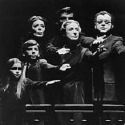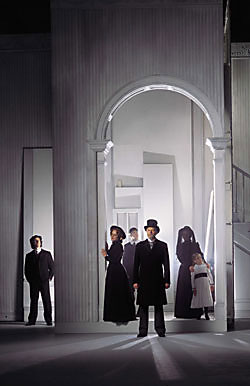|
Interview with Rich Yurman - poet, playwright and
retired Professor of English Literature and Mathematics
When did Pirandello first appear on your radar?
Probably in '72; I had already been teaching for nearly ten years and was scheduled to do a course on Modern Drama. I found a text with Shaw's Major Barbara, Brecht's Galileo, O'Neill's The Emperor Jones, William's Glass Menagerie, Miller's Death of a Salesman.
All of which you'd already seen…
Right—seen and read and knew about and felt prepared to teach. Included was also Luigi Pirandello's Six Characters in Search of an Author, which I had not previously known. I read it and it just blew my mind. This was so different from anything I'd been thinking about theater…
What had you been thinking?
Mostly the political ramifications of the story…
Like Major Barbara…
Like Galileo—and how character and conflict are developed. And that's how I was planning to teach the course—from the traditional sense that each scene is built around a conflict and these conflicts add up to the through-line of the drama, the narrative drive of the story, and how that is resolved.
Like the plays you'd seen in your teens…
My history of seeing live theater in New York was Broadway musicals and comedies, and "serious" drama like O'Neill and William Inge.
All of which fit your throughline structure…
Totally. Traditional dramatic presentations. Of course, Brecht has the idea of involving the audience but still, he roots this in a particular story onstage that is pretty straight-forward. Even Genet's The Blacks, where the actors come down from the stage and directly confront the audience members, is a political statement about racial attitudes. It made people extremely uncomfortable, but did not question its own existence as a piece of theater.
And for this class?
I had had a clear plan: the five plays from the text, plus 2 or 3 others that were more contemporary—the '60's and early '70's. Once I read Pirandello, I began re-thinking what I was aiming at for the class. And that made me think about what made modern experimental theater different from classical or traditional theater. And that led to starting the course with the traditionally structured Major Barbara to give the students a sense of how drama works. Then hit them with Pirandello.
Literally.
Yeah, literally.
Smack them.
…in the face!
 With this madness! That was long before the term "de-construction" had come into vogue, but Six Characters really is a play that de-constructs theater: what happens if you take the actor who is playing his role, the character he's trying to play, and the source of that character—the real person—and conflate the whole business. Place them all onstage at the same time. Then throw in the director, or the actor playing the director, pressure him to become the author of the play, replacing the author who created, then abandoned these characters. Cycles that go round and round: what is theater? what is real? who are the characters? who are the actors?—all thrown into a mixmaster. And through this trying to figure out not only what theater is and what it is supposed to do, but also what reality is and how reality can possibly enter into a theatrical production. That mind-blowing perspective was what I wanted the students to get. With this madness! That was long before the term "de-construction" had come into vogue, but Six Characters really is a play that de-constructs theater: what happens if you take the actor who is playing his role, the character he's trying to play, and the source of that character—the real person—and conflate the whole business. Place them all onstage at the same time. Then throw in the director, or the actor playing the director, pressure him to become the author of the play, replacing the author who created, then abandoned these characters. Cycles that go round and round: what is theater? what is real? who are the characters? who are the actors?—all thrown into a mixmaster. And through this trying to figure out not only what theater is and what it is supposed to do, but also what reality is and how reality can possibly enter into a theatrical production. That mind-blowing perspective was what I wanted the students to get.
How does that break the fourth wall?
It's not like Brecht or Genet trying to draw the audience into the action so they get politically challenged, or like a Shakespeare soliloquy stopping the action to present a character's thoughts. This is working to get the audience involved in the immediate process of theater. When you ask what I think is the most significant piece of dramatic art in the 20th century, I take that to mean what single play changed theater the most. The line of plays following Shaw certainly went on to be the most pervasive tradition through the '40's and '50's in all those shows I saw in New York and Boston. That changed in the '60's with the production of experimental writers like Beckett, Leroy Jones, et al. A real blossoming of a new dramatic structure—that, it seems to me, follows directly from Pirandello: actors interacting with audience members, actors onstage talking about what it means to play this role.
All the way to the movie Synecdoche, New York. You could do Synecdoche on stage…
[laughing] Sure, but it would be really difficult to build a set within a set and so on…
Even if you had to have a reduction of the scope, you still have the essence, even without the widescreen…
That's the thing about Pirandello. He brings, instead of the historical  or political or dramatic perspective, the psychological exploration. Suppose you take Six Characters as a literal piece—these people have experienced deep psychological traumas and now the only way they can find peace is to play out the events they lived through. They must first get someone to write the play (since the original author abandoned them). They get to watch actors pretend to be them as the play evolves and they get to criticize the actors and demonstrate how it really was. Now we have moved far from any possible literal play: the complex psychological dynamics of a family turns into questions of what it means to be an actor, to take on another self. Pirandello asks how is it possible to become rather than just pretend to be that other person who is sitting right there onstage, watching you rehearse. or political or dramatic perspective, the psychological exploration. Suppose you take Six Characters as a literal piece—these people have experienced deep psychological traumas and now the only way they can find peace is to play out the events they lived through. They must first get someone to write the play (since the original author abandoned them). They get to watch actors pretend to be them as the play evolves and they get to criticize the actors and demonstrate how it really was. Now we have moved far from any possible literal play: the complex psychological dynamics of a family turns into questions of what it means to be an actor, to take on another self. Pirandello asks how is it possible to become rather than just pretend to be that other person who is sitting right there onstage, watching you rehearse.
So it continues to be mind-blowing. Did we just outlive straight narrative? Pirandello's world now seems like an almost typical arena for the modern sensibility. Straight narrative remains an option, but only one among many.
It's still a major part of what is out there, but the list goes on and on: Orson Welles wouldn't have been Orson Welles…or shows like Noises Off wouldn't even have been possible without Pirandello's actors playing actors…
And the director coming onstage out of the audience…
…to sort things out, despite being completely "involved" with several female cast members. Go back to Hamlet. The character of "Hamlet" gives the "players" direction on how they should play these parts, and gives them extra lines to insert "to catch the conscience of a king". But that is a play performed within the main dramatic story. It isn't reflexive—it doesn't ask, on stage, "what is theater about?" The frame of Hamlet's story is not broken. In contrast, Pirandello shatters the story frame and leaves the people on stage, not just the audience, debating what is possible, what is not possible, around and around. All this comes out in much of the theater of the '70's, '80's and '90's—deconstructing theater while doing theater. Yet, it seems to me, no one has gone as far as Pirandello went. Six Characters is so shocking and so beyond anything anybody had done before 1922 that it still remains the paradigm for experimental modern theater eighty-six years later.
|


